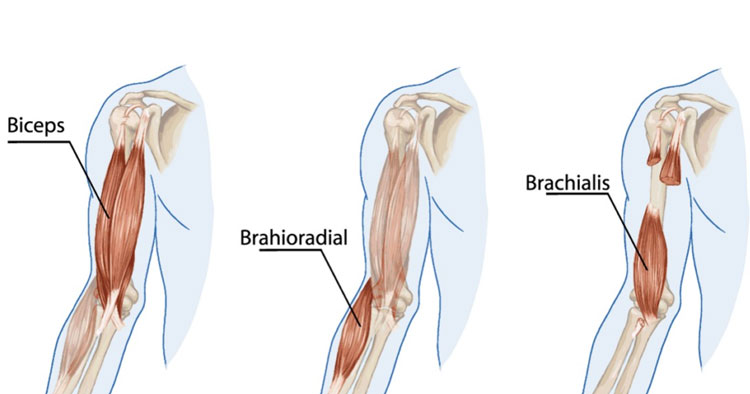Muscle Pain and Tendinopathy
Spotlight On The Brachialis Muscle
Brachialis Your Main Elbow Flexor
Brachialis (also know as brachialis anticus) is a muscle of the upper arm, your brachialis muscle lies deeper than the biceps brachii muscle and like biceps brachii is a flexor the elbow joint, meaning it bends your elbow in an action that would bring your hand towards your face. The biceps brachii muscle appears as a visible large body of muscle on the front of the upper arm and typically gets the lions share of attention from weight lifters and body builders due to the pleasing aesthetics a large bulging biceps brachii gives. However, your brachialis muscle is in fact the prime mover for elbow flexion, it has a large cross sectional area providing it with more strength than the other elbow flexors, where it actually can generate up to 50% more power than the biceps brachii muscle with regard to the elbow flexion movement. Unlike the biceps brachii, the brachialis does not insert on the radius bone of the forearm and as a result does not contribute to pronation and supination (twisting) movements of the forearm as biceps brachii can.
The Key Points
- Brachialis is positioned in what is called the anterior compartment of the upper arm, along with coracobrachialis and biceps brachii.
- Origin: The muscle originates from the distal anterior aspect of the humerus, lying deep to (underneath) the biceps brachii.
- Insertion: Insertion is on to the coronoid process and the ulnar tuberosity of the ulna just below the elbow.
- Action: It is the primary flexor of the elbow, which is as previously mentioned the motion of bending your hand up towards your shoulder, or face.
- Testing: To isolate brachialis anticus in a resisted test, the muscle is tested with the forearm in pronation (a position where the palm is facing downwards) placing the biceps brachii muscle into a mechanically disadvantaged position seeing as biceps brachii is a supinator of the forearm meaning this set up preferentially loads the brachialis.
- Injury: Weight training and climbing are possible ways to cause pain and/or injury to the brachialis muscle. Repetitive loading with the elbow extended and the arm positioned in a pronated position can stress the muscle and subsequently potentially cause injury.
Disclaimer: Sydney Physio Clinic provides this information as an educational service and is not intended to serve as medical advice. Anyone seeking specific advice or assistance on Treatment for Pes Anserinus Tendinopathy should consult his or her personal trainer, physiotherapist, general practitioner or other appropriately skilled practitioner.


